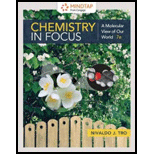
Concept explainers
Interpretation:
The given statement “a health-related website recommended taking small amounts of iodine as antioxidant to prevent aging” is to be explained.
Concept Introduction:
Oxidation is the addition of an electronegative element or the removal of an electropositive element in a
Reduction is the addition of an electropositive element or the removal of an electronegative element in a chemical reaction.
A chemical reaction in which oxidation process and reduction process take place simultaneously is called a redox reaction.
An oxidizing agent is a substance that has the capacity to oxidize the other substances and get reduced in a chemical reaction.
A reducing agent is a substance that has the capacity to reduce the other substances and get oxidized in a chemical reaction.
An antioxidant is a reducing agent. The reducing agent loses electrons easily in the chemical reaction. It reduces the other substances and gets oxidized in the
Iodine is an oxidizing agent. So, iodine will not work as an antioxidant.
Trending nowThis is a popular solution!

Chapter 14 Solutions
Owlv2 With Mindtap Reader, 1 Term (6 Months) Printed Access Card For Tro's Chemistry In Focus: A Molecular View Of Our World, 7th
- Please note that it is correct and explains it rightly:Indicate the correct option. The proportion of O, C and H in the graphite oxide is:a) Constant, for the quantities of functional groups of acids, phenols, epoxy, etc. its constants.b) Depending on the preparation method, as much oxidant as the graphite is destroyed and it has less oxygen.c) Depends on the structure of the graphic being processed, whether it can be more tridimensional or with larger crystals, or with smaller crystals and with more edges.arrow_forwardCheck the box under each a amino acid. If there are no a amino acids at all, check the "none of them" box under the table. Note for advanced students: don't assume every amino acid shown must be found in nature. ནང་་་ OH HO HO NH2 + NH3 O OIL H-C-CO CH3-CH O C=O COOH COOH + H2N C-H O H2N C H CH3-CH CH2 HO H3N O none of them 口 CH3 CH2 OH Хarrow_forwardWhat is the systematic name of the product P of this chemical reaction? 010 HO-CH2-CH2-C-OH ☐ + NaOH P+ H2Oarrow_forward
- 1. Provide missing starting materials, reagents, products. If a product cannot be made, write NP (not possible) in the starting material box. a) C10H12 Ph OMe AcOHg+ + enantiomer Br C6H10O2 + enantiomerarrow_forwardDraw the Fischer projection of the most common naturally-occurring form of cysteine, with the acid group at the top and the side chain at the bottom. Important: be sure your structure shows the molecule as it would exist at physiological pH. Click and drag to start drawing a structure. :☐ ©arrow_forwardDraw an a amino acid with an ethyl (-CH2-CH3) side chain. Draw the molecule as it would appear at physiological pH. Click and drag to start drawing a structure. :□ S टेarrow_forward
- Write the systematic name of each organic molecule: HO Cl structure O OH O HO OH name ☐ OH OH ☐ OH ☐arrow_forwardWrite the name of a naturally-occuring hydrophillic amino acid. (You will find the structures of the naturally-occuring amino acids in the ALEKS Data resource.) × $arrow_forwardPlease note that it is correct and explains it rightly:The proportion of O, C and H in the graphite oxide is:a) Constant, for the quantities of functional groups of acids, phenols, epoxy, etc. its constantsb) Depending on the preparation method, as much oxidant as the graphite is destroyed and it has less oxygenc) Depends on the structure of the graphic being processed, whether it can be more three-dimensional or with larger crystals, or with smaller crystals and more borders.arrow_forward
- The proportion of O, C and H in the graphite oxide is constant, only the cantidades of functional groups of acids, phenols, epoxy, etc. its constants. ¿Is it correct?arrow_forwardThe proportion of O, C and H in the graphite oxide depends on the structure of the graph that is processed, which may be more tridimensional or with larger crystals, or with smaller crystals and more borders. ¿Is it correct?arrow_forwardIn mixed oxides with superconducting properties, we find Cu:a) Frequentlyb) Alwaysc) Almost neverarrow_forward
 Chemistry: Principles and PracticeChemistryISBN:9780534420123Author:Daniel L. Reger, Scott R. Goode, David W. Ball, Edward MercerPublisher:Cengage Learning
Chemistry: Principles and PracticeChemistryISBN:9780534420123Author:Daniel L. Reger, Scott R. Goode, David W. Ball, Edward MercerPublisher:Cengage Learning ChemistryChemistryISBN:9781305957404Author:Steven S. Zumdahl, Susan A. Zumdahl, Donald J. DeCostePublisher:Cengage Learning
ChemistryChemistryISBN:9781305957404Author:Steven S. Zumdahl, Susan A. Zumdahl, Donald J. DeCostePublisher:Cengage Learning Chemistry: An Atoms First ApproachChemistryISBN:9781305079243Author:Steven S. Zumdahl, Susan A. ZumdahlPublisher:Cengage Learning
Chemistry: An Atoms First ApproachChemistryISBN:9781305079243Author:Steven S. Zumdahl, Susan A. ZumdahlPublisher:Cengage Learning
 Chemistry: The Molecular ScienceChemistryISBN:9781285199047Author:John W. Moore, Conrad L. StanitskiPublisher:Cengage Learning
Chemistry: The Molecular ScienceChemistryISBN:9781285199047Author:John W. Moore, Conrad L. StanitskiPublisher:Cengage Learning World of ChemistryChemistryISBN:9780618562763Author:Steven S. ZumdahlPublisher:Houghton Mifflin College Div
World of ChemistryChemistryISBN:9780618562763Author:Steven S. ZumdahlPublisher:Houghton Mifflin College Div





